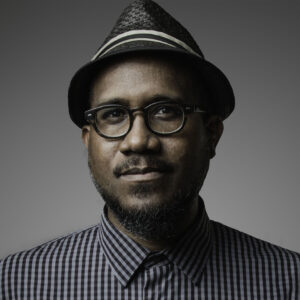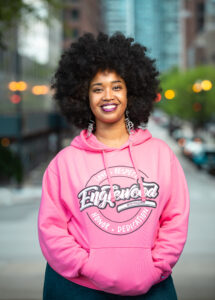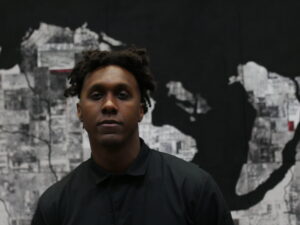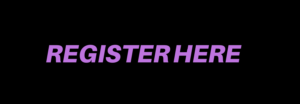Artists Andres L. Hernandez, Tonika Lewis Johnson and Roland Knowlden consider the many definitions of space, site, and home.
Spatial griots Andres L. Hernandez, Tonika Lewis Johnson and Roland Knowlden invite you to consider how socio-economic and geographic oppressions impact the way we see (or don’t see) our environments. Hernandez uncovers embedded histories and systems of power within built and speculative landscapes to imagine these spaces otherwise. Social justice artist Lewis Johnson advocates for urban communities by documenting the disparities among Chicago residents who live on opposite ends of the same streets across the city’s racial and economic divides. Knowlden critically deconstructs the elements of our urban fabric and its architectural histories to reassemble them as cartographic abstractions and imagined landscapes.
Gwendolyn Brooks, a brilliant author, poet, and life-long resident of the historic neighborhood of Bronzeville, becomes the Mecca of these stories as this exhibition interrogates dilapidation, buried histories, and what it could mean to be Black in space. Architecture is an ever-present form of storytelling. The architectural historiographies of Black space have often been written by poets who have elegantly told our stories of spatiality. Brooks gave us a voice we didn’t know we needed while underlining the importance of Black interiority. Like Brooks, June Jordan has used poetry to advocate for Black lives. Jordan was an architect, through a feminist practice that centers how we think about cartographies. Jordan invited us to challenge and redefine prevailing socio-spatial constructs towards dignified spaces for all communities. This is one of many reasons why she is an additional pinnacle of reference for an exhibition which poetically grapples with the many definitions of space, site, and home.

Andres L. Hernandez is a Chicago-based interdisciplinary practitioner. Initially trained as an architect, he has previously worked within architectural offices, community organizations, public schools, museums, and other institutional contexts.
Hernandez’ projects include commissions for the University of Arizona School of Art; 2018 Venice Architecture Biennale; and Pulitzer Arts Foundation and Sam Fox School of Design & Visual Arts at Washington University in St. Louis. With Dark Adaptive, he co-developed performances for The Drawing Center; MoMA; Sharjah Biennial; and Performa. Hernandez held artist residencies with MCA Chicago; University of Arizona; Chicago DCASE; and University of Chicago. He participated on design teams for the 2021 Chicago Architecture Biennial, and the Museum of the Obama Presidential Center. His awards include the Efroymson Family Fund Contemporary Arts Fellowship, and the 3Arts Award in Visual Arts.
Hernandez is currently an Associate Professor at the School of the Art Institute of Chicago.
“My work draws forward the latent potential of words, spaces, sounds, and movement to elicit liberatory ways of being. I explore the embedded attitudes, histories, policies, and systems of power within and beyond our world(s) as a method of imagining and existing otherwise. I site my practice at the intersection of the social and the spatial. I consider the symbiotic, yet, fraught relationships between built and natural environments and their inhabitants, and speculate alternative pasts, presents, and futures for all. My work takes many forms, including collaborative and socially-engaged works, as well as independent, studio-based practices. Drawing, installation, and writing are my preferred media, alongside sound and performance”.
https://andreslhernandez.com/

Tonika Johnson is a photographer, social justice artist and life-long resident of Chicago’s Southside Englewood neighborhood. Her art explores urban segregation and celebrates the nuanced richness of the Black community, countering media depictions of Chicago’s violence. Tonika’s work reveals injustices and inequalities, past and present, evidenced in the built environment and enshrined in real estate and land use practices, including historic preservation. Her Folded Map Project™ brings residents who live at similar addresses but miles apart on Chicago’s racially segregated South and North sides together in conversation about the city’s racial and economic divides. The Folded Map Project™ questions how everyone is socially impacted by racial and institutional conditions segregating the city and challenges viewers to contribute to a solution.
Tonika was selected as the National Public Housing Museum’s 2021 Artist as Instigator to expand her investigation through “Inequity for Sale,” a project highlighting the living history and legacy of greater Englewood homes sold through Land Sale Contracts in the 1950s and 1960s, which led to the unscrupulous loss of people’s homes and equity preventing the generational transfer and building of Black wealth. Tonika’s artistic contributions have gained citywide recognition in the last seven years, including being named a 2017 Chicagoan of the Year by Chicago Magazine, being exhibited at the Museum of Contemporary Art, the Rootwork Gallery in Pilsen, the Chicago Cultural Center, the Harold Washington Library Center and at Loyola University’s Museum of Art. She is a 2019 Field Foundation “Leader for a New Chicago” and a Chicago Department of Cultural Affairs and Special Events Cultural Advisory Council member. In 2022, Landmark Illinois’ named her one of their Influencers for her “Inequity For Sale.”
Tonika is the co-founder of the Englewood Arts Collective and Resident Association of Greater Englewood, and she now serves as the Creative Executive Officer of the Folded Map Project™ nonprofit organization.
https://www.tonijphotography.com/

Roland Knowlden is a Liberian American interdisciplinary artist and architectural designer from New Jersey, currently based in Chicago, IL. Knowlden’s architectural background has cultivated his ongoing interest in constructed landscapes, city planning, and the cultural and social implications of racialized spatial mapping. Working across painting and drawing, Knowlden’s approach to abstract and experimental mapping articulates a visual language which makes visible the tensions wrought by erasure, displacement, and palimpsest.
Interrogating notions of origin, belonging, boundaries, and power, Knowlden’s critical cartography aims to not only reproduce existing environmental experiences and affects, but to propose new spatial realities. With each new configuration and composition, Knowlden furthers his practice of imagining otherwise.




